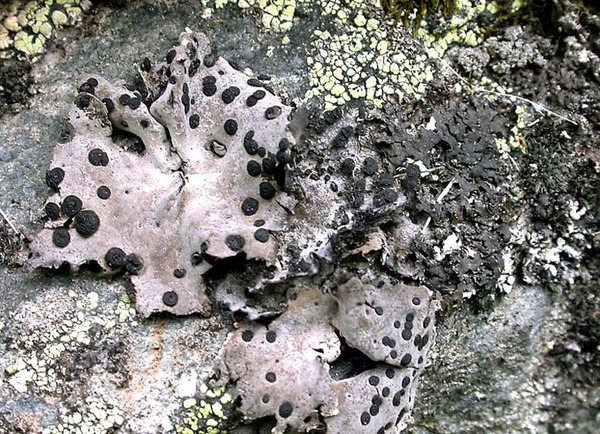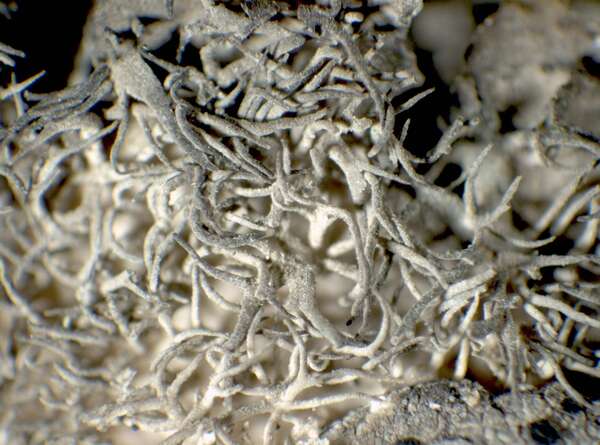Umbilicaria cylindrica var. delisei Nyl.
Despr. ex Nyl., Lichenes Scand.: 117, 1861.
Synonyms: Gyrophora cylindrica var. delisei (Nyl.) Th. Fr.; Umbilicaria canescens (Dombr.) Dombr.; Umbilicaria delisei (Nyl.) Kremp.
Distribution: N - TAA (Nascimbene & al. 2022), Piem (Isocrono & al. 2006, 2006b), VA (Piervittori & Isocrono 1999, Matteucci & al. 2015c).
Description: Thallus foliose-umbilicate, heteromerous, dorsiventral, usually monophyllous, 6-10 cm wide, the lobe margins almost bare, only young lobes with a few flat, densely branched black cilia. Upper surface pale to dark grey, sometimes tinged brown, dull, slightly wrinkled or almost even, sometimes with a few folds and ridges around the umbilicus, giving way to a reticulate pattern. Lower surface grey-white, distinctly pink towards the umbilicus, even, smooth, the area around the umbilicus naked, the rest with moderately numerous thin, long, cylindrical, pale, simple rhizinomorphs; thalloconidia absent. Upper cortex 10-20 µm thick; medulla white, 3-layered, the upper and lower layers loose, with an arachnoid plectenchyma, the layer inbetween with a compact plectenchyma; lower cortex 10-20 µm thick, scleroplectenchymatous. Apothecia numerous, black, gyrodisc, markedly stipitate, to 2-5 mm across, convex with few deep gyri. Epi- and hypothecium dark; hymenium colourless. Asci 8-spored, clavate, thick-walled, with an amyloid apical dome, Umbilicaria-type. Ascospores 1-celled, hyaline, ellipsoid, 8-15 x 3–9 µm. Pycnidia numerous, immersed, bottle-shaped, with a brown wall, and a dark brown ostiole. Conidia c. 3-4 x 0.8 µm. Photobiont chlorococcoid. Spot tests: medulla K- or K+ yellow turning red, C-, KC- or KC+ faintly red, P- or P+ orange. Chemistry: medulla with variable amounts of norstictic acid and sometimes with very low amounts of gyrophoric and lecanoric acids. Note: more hygrophytic than the typical variety, and often found in sheltered situations, such as in niches of the rock.
Growth form: Foliose, umbilicate
Substrata: rocks
Photobiont: green algae other than Trentepohlia
Reproductive strategy: mainly sexual
Commonnes-rarity: (info)
Alpine belt: rare
Subalpine belt: rather rare
Oromediterranean belt: absent
Montane belt: absent
Submediterranean belt: absent
Padanian area: absent
Humid submediterranean belt: absent
Humid mediterranean belt: absent
Dry mediterranean belt: absent

Predictive model
Herbarium samples
Growth form: Foliose, umbilicate
Substrata: rocks
Photobiont: green algae other than Trentepohlia
Reproductive strategy: mainly sexual
Commonnes-rarity: (info)
Alpine belt: rare
Subalpine belt: rather rare
Oromediterranean belt: absent
Montane belt: absent
Submediterranean belt: absent
Padanian area: absent
Humid submediterranean belt: absent
Humid mediterranean belt: absent
Dry mediterranean belt: absent

Predictive model
| Herbarium samples |
 Index Fungorum
Index Fungorum
 GBIF
GBIF





